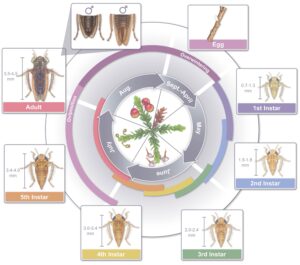New Jersey cranberry growers are increasingly concerned about the rising populations of blunt-nosed leafhoppers (BNLH). This increase is likely linked to shifts in pest management strategies, including the adoption of reduced-risk insecticides and reduced use of broad-spectrum products, as well as the expansion of high-yielding cranberry varieties. BNLH is particularly troubling because it transmits a phytoplasma—a type of bacterium—that causes false blossom disease (Figure 1). Symptoms of this disease include stunted growth, deformed and sterile flowers that point upward, and a characteristic branching of upright shoots known as witches’ broom.

Figure 1. Healthy cranberry (left) and phytoplasma-infected cranberry (right). Drawing by Lindsay Lindhult.
Life Cycle
The blunt-nosed leafhopper (BNLH) has one generation per year (Figure 2). Its eggs overwinter embedded in cranberry stems and begin hatching in early May. Nymphs pass through five instars over the course of about 2 months. Adults emerge in early July, peak in mid to late July, and decline by the first week of August. These adults are characterized by their distinctive blunt heads and vary in color from light yellowish-gray to dark brown. Egg-laying occurs between July and August.
Damage
Nymphs and adults feed on cranberry plant juices using their piercing-sucking mouthparts. While this direct feeding causes little visible damage, BNLH is an important pest because it serves as a vector for the phytoplasma that causes false blossom disease.
Management
At this time of year eggs should be hatching and early-instar nymphs should be active (Figure 2).

Figure 2. Life cycle of blunt-nosed leafhopper. Drawing by Lindsay Lindhult.
Here are some guidelines to consider when managing BNLH in cranberries:
Identify Infestation Sites: The key to effective BNLH control is identifying infestation sites. The most reliable method for monitoring this insect is by using a sweep net. Before bloom, use sweep nets to collect nymphs. Because nymphs are small and difficult to see, bag and freeze the samples to kill them, then count the nymphs using a microscope or magnifying lens.
Sweep net Monitoring: Perform sweep sets of 25 sweeps each. The recommended number of sweep sets is:
- 1 per 1–10 acres
- At least 10 sweep sets per 10–20 acres
- 1 sweep set per 2 acres for areas larger than 20 acres
Lack of Economic Thresholds: Establishing an economic threshold for BNLH is difficult, as the proportion of false blossom infected individuals within BNLH populations is unknown and may vary by cranberry variety and location. Notably, higher infection rates have been observed in newer varieties, even when BNLH populations are low.
Control Measures: Control measures should be based on BNLH population trends relative to previous years, the history of insecticide applications, and the cranberry variety grown. If BNLH populations are increasing compared to prior seasons and the beds have not been treated for BNLH in the past 2–3 years, treatment should be considered.
Treatment Options: If treatment is necessary, consider the following options to manage BNLH:
- Timing: The best time for insecticide treatment is before bloom to target young nymphs.
- Insecticide Options:
Organophosphates: Diazinon (diazinon), Orthene (acephate)
Carbamates: Sevin (carbaryl)
Pyrethroids: Fanfare or Brigade (bifenthrin), Danitol (fenpropathrin)
Neonicotinoids: Assail (acetamiprid), Actara (thiamethoxam). Note: Use neonicotinoids with caution before bloom due to their potential negative effects on pollinators. These systemic insecticides can accumulate in pollen and nectar, posing a risk to bees.
Sulfoximine: Closer (sulfoxaflor). Although effective in small plot trials at the P.E. Marucci Center, more data are needed to confirm efficacy on larger commercial scales.
- Be aware that, while not scientifically proven, there are claims that Orthene and Sevin may reduce pollinator activity by repelling bees.
- Rotate insecticides with different modes of action to prevent the development of resistance in BNLH populations.

